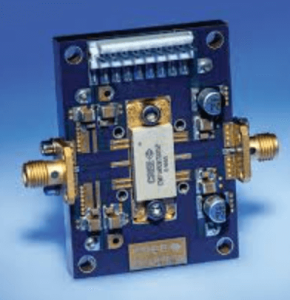
Radio Frequency Integrated Circuits ( RF ICs) are specialized semiconductors designed to process signals in the radio frequency spectrum (3 kHz to 300 GHz). These circuits are the backbone of modern wireless communication, enabling technologies like smartphones, Wi-Fi, Bluetooth, and radar systems. As demand for faster, more reliable wireless connectivity grows, RF ICs play a pivotal role in advancing 5G, IoT, and satellite communications.
Table of Contents
ToggleKey Components of RF ICs
- Amplifiers:
- Low-Noise Amplifiers (LNAs): Boost weak signals with minimal added noise, crucial for receivers.
- Power Amplifiers (PAs): Increase signal strength for transmission, often requiring high efficiency and linearity.
- Mixers: Convert frequencies by combining two signals, essential for upconversion (transmitting) and downconversion (receiving).
- Oscillators: Generate stable carrier frequencies. Voltage-Controlled Oscillators (VCOs) are common, often paired with Phase-Locked Loops (PLLs) for frequency stability.
- Filters: Selectively pass or block frequencies. Types include SAW (Surface Acoustic Wave) and BAW (Bulk Acoustic Wave) filters.
- Modulators/Demodulators: Encode/decode data onto/from RF carriers using schemes like QAM and OFDM.
- Phase-Locked Loops (PLLs): Maintain signal synchronization and reduce jitter in frequency synthesis.
Types of RF ICs
- RF Amplifiers: LNAs for receivers, PAs for transmitters.
- Transceivers: Integrate transmitters and receivers (e.g., Wi-Fi/Bluetooth chips).
- RF Switches: Route signals between antennas and components.
- RF Front-End Modules ( FEMs): Combine PAs, LNAs, switches, and filters for compact designs.
Technologies and Materials
- CMOS: Cost-effective with high integration for digital/analog systems, though limited at high frequencies.
- GaAs: High electron mobility ideal for mmWave and high-power applications (e.g., radar).
- SiGe: Balances performance and cost, suitable for mixed-signal designs.
- GaN: Emerging for high-power, high-frequency uses like 5G base stations.
Applications
- Wireless Communication: 5G, Wi-Fi 6/6E, Bluetooth LE.
- IoT: Low-power sensors for smart homes and industrial IoT.
- Automotive: Radar and V2X (Vehicle-to-Everything) communication for ADAS.
- Aerospace: Satellite communication and avionics.
- Medical: Wireless implants and telemetry systems.
Design Challenges
- Noise and Linearity: Minimize noise (critical for LNAs) and maintain linearity to prevent distortion.
- Power Efficiency: Vital for battery-powered devices; techniques like envelope tracking optimize PA efficiency.
- Thermal Management: High-frequency operation generates heat, requiring advanced cooling solutions.
- Integration: Combining analog RF with digital circuits on a single die introduces interference risks.
- Impedance Matching: Ensures maximum power transfer using LC networks or transmission lines.
Testing and Validation
- S-Parameters: Analyze signal reflection/transmission in high-frequency networks.
- Noise Figure Measurements: Assess signal degradation in receivers.
- Spectrum Analysis: Detect spurious emissions and harmonics.
- Simulation Tools: Keysight ADS, Ansys HFSS, and Cadence Virtuoso for pre-fabrication modeling.
Future Trends
- mmWave and 6G: Frequencies above 24 GHz for ultra-high-speed data, enabled by beamforming and MIMO.
- AI Integration: Machine learning for adaptive signal processing and error correction.
- Energy Harvesting: RF-based power scavenging for sustainable IoT devices.
- Advanced Packaging: 3D ICs and heterogeneous integration to enhance performance while shrinking size.
- GaN Adoption: Expanding into consumer electronics for efficient high-power applications.
Conclusion
RF ICs are indispensable in the wireless era, driving innovations across communication, healthcare, and automotive industries. As technologies evolve, challenges like power efficiency and thermal management will spur advancements in materials, design methodologies, and integration techniques. Understanding RF ICs’ intricacies is key to harnessing their potential in future wireless ecosystems.
This guide provides a structured overview of RF ICs, from fundamental components to cutting-edge trends, offering insights for engineers, students, and tech enthusiasts alike.
- Everything You Need To Know About Limit Switch - May 21, 2025
- Everthing You Should Know About Rheostat - May 20, 2025
- Everything You Need To Know About Reversing Contactor - May 19, 2025






